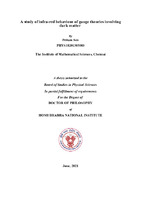- DSpace Home
- →
- IMSc Theses/ Dissertations
- →
- IMSc Theses/ Dissertations
- →
- View Item
JavaScript is disabled for your browser. Some features of this site may not work without it.
| dc.contributor.author | Pritam Sen | |
| dc.date.accessioned | 2021-12-14T10:15:03Z | |
| dc.date.available | 2021-12-14T10:15:03Z | |
| dc.date.issued | 2021 | |
| dc.date.submitted | 2021-06 | |
| dc.identifier.uri | https://dspace.imsc.res.in/xmlui/handle/123456789/591 | |
| dc.description.abstract | This thesis concerns the demonstration of infrared (IR) finiteness of a thermal theory of neutrals interacting with charged fermions and scalars to all orders in perturbation theory specifically in the context of theories involving dark matter (DM). DM is predominantly conjectured to be thermally produced in the early Universe, staying in equilibrium with the background plasma until the occurrence of freeze-out. The thermal effects being of cru- cial importance can contribute appreciably while predicting the relic density of DM while trying to delineate the parameter space of models of viable DM candidates. The IR struc- ture of the concerned theories are of great importance, playing a pivotal role while trying to predict the relic density reliably. The IR structure of theories is well known to become more intricate at finite temperature due to the presence of thermal fluctuations in addition to already present quantum fluctuations. In addition to this, at finite temperature, both the emission to and absorption of real particles from the heat bath also become feasible, mak- ing the situation more involved. To account for all these intricacies, the extension of the Grammer and Yennie (GY) technique [Phys. Rev. D 8 (1973), 4332] to finite temperature as was originally prescribed by Indumathi [Annals Phys. 263 (1998), 310] for the case of thermal purely fermionic QED, is implemented to unambiguously identify the correct IR divergent and finite pieces. As the theories of DM often involve charged scalars and fermions, we start by analyzing the IR structure of the thermal theory of scalar QED. The theory of charged scalars also involve quadrilinear seagull vertices in addition to usual tri- linear interaction vertices. After applying the extension of GY technique, the IR divergent pieces of both the virtual and real photon contributions are found to factorize, leading to exponentiation and resummation. The quadrilinear seagull and tadpole diagrams play an indispensable role to obtain this neat IR factorization and resummation by exactly cancel- ing out respectively the remnant IR finite linear and quadratic terms in photon momentum that would otherwise spoil the factorization, at all orders, of the purely IR divergent terms at finite temperature. The IR divergent pieces arising in the virtual and real contributions are found to cancel among themselves, making the theory of thermal charged scalars IR finite to all orders in perturbation theory. We then focus our attention to a theory of DM involving interactions with charged scalars and charged fermions. The similar analysis of IR structure for this full theory having different kind of particles, after implementing the extension of GY technique becomes highly involved. We observe non-trivial double cancellations among terms after applying GY reduction. The IR divergent terms again factorize and get resummed into an exponential factor in both virtual and real photon con- tributions. The IR divergent pieces then cancel among the appropriate virtual and real contributions making the theory of DM to be IR finite to all orders in perturbation theory at finite temperature. The IR factorization, resummation and cancellation are found to be independent of the specific nature of the interaction term of neutrals, charged scalars and charged fermions making the proof and results of IR finiteness to be well applicable for a general thermal theory of neutrals interacting with charged fermions and scalars. This proof of IR finiteness was only possible after accounting for both the real photon emission to and absorption from the heat bath. Hence in this thesis, we establish, for the first time, the all-order proof of the infra-red finiteness of thermal field theories relevant to the study of dark matter. The effect of the heat bath is found to become perceptible at observable energy resolution giving rise to discernible temperature dependent finite corrections above soft limit. This finite contribution has been studied upto next-to-leading (NLO) order by Beneke and collaborators [JHEP 10 (2014), 045] but is beyond the scope of this thesis. | en_US |
| dc.publisher.publisher | ||
| dc.subject | HBNI Th202 | en_US |
| dc.subject | infra-red behaviour | en_US |
| dc.title | A study of infra-red behaviour of gauge theories involving dark matter [HBNI Th202] | en_US |
| dc.type.degree | Ph.D | en_US |
| dc.type.institution | HBNI | en_US |
| dc.description.advisor | D. Indumathi | |
| dc.description.pages | 207 | en_US |
| dc.type.mainsub | Physics | en_US |
| dc.publisher | The Institute of Mathematical Sciences | |
| dc.type.hbnibos | Physical Sciences |
Files in this item
This item appears in the following Collection(s)
-
IMSc Theses/ Dissertations
IMSc Theses/ Dissertations
